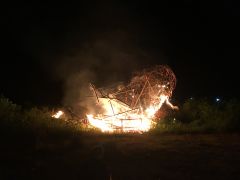Silence is becoming every more scarce in the world of today, drenched as it is in ubiquitous noise. We are living in a world swarming with constant and frenetic movement, one of the many negative consequences of which is the continuous flow of superimposed sonic events of low quality.
Try to stand on a busy street in the middle of the rush hour and have a conversation with a person standing one meter away without raising your voice. You will not hear a word of the other person’s speech. And now, since our sonic environment has been effectively colonized by all kinds of noise-producing gadgetry which we all use everyday, it almost seems that there is no escape from noise. Even rural soundscapes, originally distinguished by their quiet and tranquility, are dominated by the racket of power mowers, saws, all-terrain vehicles and motorbikes and those newest sound pollutants of the sky, drones.
Times have changed and so has our sonic environment. In his foundational work of sound ecology, The New Soundscape, Raymond Murray Schafer makes the claim that in history, silence was a highly valued privilege, of which we are gradually being divested:
In the past there were muted sanctuaries where anyone suffering from sound fatigue could go into retirement for recomposure of the psyche. It might be in the woods, or out at sea, or on a snowy mountainside in winter. One would look up at the stars or the soundless soaring of birdcraft and be at peace.
It was understood that each human being had an inalienable right to stillness. It was a precious article in an unwritten code of human rights.
Considering the onslaught of decibels charging at us everyday from all directions, Schafer’s account may seem a fantastic fairytale from a bygone time and might seem highly utopian to us today. You may argue that a walk in the woods, a sojourn in the country or a hike in the mountains could perfectly provide you with a noiseless environment and with the rewarding peace of mind that Schafer so idealistically describes. Indeed, the level of man-made ambient noise in such places should be considerably reduced. However, would you leave behind your cel phone, headphones, perhaps even a bluetooth speaker for such an outing? Wouldn’t you travel to these places with some company for conversation; and wouldn’t you drive or use some other noisy means of transport to get there?
What I am getting at is, that in order to liberate ourselves from noise (and not just the noise of the ear, but noise in general as interference in our thoughts), we have to realize an important fact — that we ourselves, together with our creations, are the major producers of noise on this planet. Schafer, the founder of the World Soundscape Project and pioneer of sound ecology who devoted much of his professional life to “silencing the world” and noise abatement, claims that the Industrial revolution began, as in really all spheres of human activity, a major shift in the sonic history of our planet, radically altering the soundscapes of the world, accompanied by a dramatic increase in the level of ambient noise. Porteous and Mastin sum up the current sensory conditions of urban dwellers in a thought-provoking piece, stating that the their sensory experience is greatly impaired, leading to a decreased quality of life:
Urban man increasingly inhabits an environment of sensory overload emphasized by his predilection for noisy technological gadgets. In sensory terms, this same environment is actually an environment of privation. Visual blight, the smell and taste of smog, and the masking effect of keynote city sounds increasingly deprive the urbanite of high quality visual, aural and odiferous experiences.
Therefore, despite the fact that we are living in an era distinguished by hi-fi forms sonic reproduction, we have gradually relegated our sonic environment to a lo-fi state, in which “individual acoustic signals are obscured in an overdense population of sounds,” practically reducing it to “sound sewage.” And since every action — even the smallest movement — produces sound, it goes without saying that without slowing down our pace and forfeiting some of our more clamorous gadgets, we will not be able to improve our acoustic environment in an appreciable way.
One Day of Silence
Nyepi, or the “Day of Silence,” represents one of the most significant holidays in Bali — a day which paradoxically stands out due to the inactivity and stillness that sets in on the island as Bali becomes shrouded in darkness and silence. On this first day of the new Balinese year (based on the lunar Saka calendar), which this year fell on 17 March, lasting 24 hours beginning at 6 AM, people are not permitted to travel, work, light fires, or indulge in entertainment; and the more pious ones even refrain from eating and drinking. Rather than indulging in these earthly pleasures, they are supposed to devote themselves to meditation, self-reflection and fasting. The airport is closed, streets are deserted — with the sole exception of the Pecalang (traditional Balinese security officers) who make sure that the restrictions are obeyed by everyone, including tourists. Moreover, to make sure that people do not become distracted from their spiritual composure, a regulation was passed this year coercing internet providers to shut down all internet services, thus preventing whomever happens to be on the island during this time from escaping into the virtual and digital worlds.
The restrictions that must be observed on Nyepi include Amati Geni, prohibiting the use of fire or light, including electricity; Amati Karya, the prohibition of work; Amati Lelunganan, the prohibition of travelling; and Amati Lelanguan, the order of fasting and the restriction on indulging in revelry or entertainment. Of course, not all Balinese themselves observe all of these restrictions, but the majority generally refrain from leaving their houses or compounds, using lights and fire and also try to avoid making loud noises. On the other hand, the more pious ones find themselves in a difficult situation due to the fact that this year, the day of Nyepi coincided with another Hindu holiday, to Saraswati, the Goddess of knowledge, on which Hindus pray to her in temples and adorn the temple books with offerings; for such activities are prohibited on Nyepi. And unlike other Hindu holidays and ceremonies, which are celebrated almost exclusively within the Hindu community, Nyepi must be observed by everyone which gives an opportunity even to the visitors of the island to experience a unique ritual of abnegation.
The Utopia of Silence
It is precisely in such utopian pockets of radically transformed everyday reality as on Nyepi — be they distinguished by inactivity or any unusual activities which temporarily overthrow the established normalcy — that we are confronted with a valuable reflection of the arbitrariness and artificiality of our everyday realities. We come to realize how constructed our everyday behaviour is — rather than living the reality, we are performing it without being aware of it. No wonder this highly studious and socially constructed nature of what we call “reality” has become the focus of research of many philosophers, sociologists and anthropologists in the second half of the 20th century, including Theodor Adorno, Michel Foucault, Jean Baudrillard and many others.
For instance, Erwing Goffman, who studied the performative nature of everyday behaviour in great detail, wholly subscribes to the socially constructed nature of reality in his Presentation of Self in Everyday Life:
To the degree that a performance highlights the common official values of the society in which it occurs, we may look upon it, in the manner of Durkheim and Radcliffe-Brown, as a ceremony — as an expressive rejuvenation and reaffirmation of the moral values of the community. Furthermore, in so far as the expressive bias of performances comes to be accepted as reality, then that which is accepted at the moment as reality will have some of the characteristics of a celebration. To stay in one’s room away from the place where the party is given, or away from where the practitioner attends to his client, is to stay away from where reality is being performed. The world, in truth, is a wedding.
Furthermore, Goffman elaborated his claim that all our social interactions are essentially micro-performances which we act out in front of our audiences, in which we effectively mold our identities in such a way as to fit in more smoothly in particular social contexts:
When we examine a group or classs, we find that the members of it tend to invest their egos primarily in certain routines, giving less stress to the other ones which they perform. Thus a professional man may be willing to take a very modest role in the street, in a shop, or in his home, but, in the social sphere which encompasses his display of professional competency, he will be much concerned to make an effective showing.
However, it would be misleading to presume that we simply act in accordance with the expectations of our audiences and that we do not try to manipulate them and swing them to our side. As Goffman affirms: “When an individual appears before others, he wittingly and unwittingly projects a definition of the situation, of which a conception of himself is an important part.” The individual therefore musters his or her powers of deception to present what Goffman calls the “front,” a fixed image of oneself by which one strengthens the impressions that he or she is trying to give to others. Eventually, there might exist many motivations and situations that will prompt us to perform a specific role: “Thus, when an individual appears in the presence of others, there will usually be some reason for him to mobilize his activity so that it will convey an impression to others which it is in his interests to convey.”
Yet, if we are so intent on acting out those roles which promote our self-interests in particular situations as Goffman claims, what do we get from taking part in communal activities and rituals in which our roles are highly predetermined and practically invariable? And moreover, how do we profit from performing passive roles, i.e. “negative roles” — which require us to refrain from performing at all or to stop performing for “the sake of performing”?
In an attempt to answer these questions, it may be useful to look into the concept of “liminality” as developed by American anthropologist Victor Turner in his study of rituals and social dramas from the perspective of performance. Turner adopts the term liminality in his Anthropology of Performance to describe a dynamic state of affairs in rituals and social drama, in which social processes lose their grounds and their designated functions in the structure of society and can thus be freely manipulated and reorganized. In Revelation and Divination in Ndembu Ritual Turner claims that in such a state “all social structural statuses, roles, and rules cancel one another, leaving a liminal space that is at once pure act and pure potentiality, a zero that is all.”
And indeed, if we apply this definition of the liminal space opened by Nyepi, we will realize that silence represents a very fitting condition of “pure potentiality” and by way of the “zero that is all.” If we attempt to perceive silence not merely as the lack of sound, but rather from the Cagean perspective as the field upon which all potential sounds can be realized, we arrive at the affirmation that silence delivers the ability to listen with the utmost authenticity, potency and intensity to whatever sounds happen to occur in our surroundings.
Moreover, according to Turner, in occupying the liminal space, the participants of a ritual are “neither here nor there; they are betwixt and between the positions assigned and arrayed by law, custom, convention, and ceremony.” This position “betwixt and between” marks a territory where the self appears, relieved of the burden of identity, exposed to the most intensive self-reflection. And self-reflection, together with meditation and praying, is indeed one of the activities people are customarily ordered to perform on Nyepi. The ordained silence should serve as the indispensable setting for this self-reflection as well as a means of eliminating any potential sonic distractions that may engage our attention, very much like darkness in terms of visual perception.
The Purtification of the Senses
However, Nyepi is not simply a silent day tucked in between other loud days — it is a silent day which takes place after a really loud day and that bears its significance. It represents the final, reconciliatory or remedial phase of the Balinese new year celebrations. These start wth the Melasti purification ceremony, occurring two, three or four days before Nyepi, when communities of Hindu worshippers venture onto beaches or to springs (sources of tirtha, or holy water) with Pratima shrines containing holy objects (such as Rangda or Barong masks or Wayang puppets) which need to be purified. The positive deities are blessed with offerings and prayers and animals are sacrificed in order to placate evil spirits or demons.
But it is the night before Nyepi that the true festive atmosphere sets in on the island. Everyone comes out on the streets to witness the Pengerupukan, or the parades featuring Ogoh-Ogoh, gigantic statues of demons made of styrofoam which the locals have spent the previous several months making and decorating. The Ogoh-Ogoh processions roam the streets, accompanied by the Gamelan Beleganjur marching troupes playing unbelievably loud and fast proto-funk music featuring interlocking and accentuated rhythms produced by piercing ceng-ceng cymbals, throbbing gongs, rumbling kendang drums and other more or less easily portable instruments.
Recording: Pengerupukan at Mertasari Beach, Sanur : mp3
After the procession, the Ogoh-Ogoh would be usually burnt, thus banishing the evil spirits which had been absorbed by the giant dolls in the process of playing loud music and marching with them. The ordained silence and the prohibition of using lights on Nyepi are motivated by an effort to deceive the demons into thinking that Bali is deserted, so that they will not return. However, there are many explanations as to what this ritual burning is supposed to represent and none of them seem to be universally accepted by all Balinese. Moreover, since the creation of Ogoh-Ogoh requires considerable effort and financial expenses for the community or local councils, called “Banjar” in Bali, which sponsor their creation and on whose grounds the Ogoh-Ogoh are exhibited before and after the procession, most Banjars have abandoned the custom of burning them and instead try to sell them to private owners to recover some of the expenses.
Nevertheless, if we accept the metaphor of the transformation of loud sounds into a force imbued with evil spirits, the opposing positive aspects of the prescribed silence of Nyepi may appear much more apparent and pronounced to us. When the liminality of festivity and loudness, which aims at a climax of intensity and sonic saturation, shifts into the remedial liminality of silence, one enters a very special realm — when one gets up in the morning of Nyepi to the symphony of birds, frogs, lizards, insects and other active sonic participants of the biophony without the usual din of motorbikes and cars which constantly obscures these sounds in an urban soundscape. Then one is able to fully experience a very special unity with all the living and the sheer beauty of the harmony and balance that emanates from one’s surroundings.
Recording: Nyepi, morning : mp3
However, indulging in listening to the “world symphony” — a term that Schafer so poignantly uses to refer to the co-existence of sounds around us, will hardly be the priority for all of us. The primary obstacle that any noise abatement measures or prospects for the improvement of our soundscapes have to overcome is peoples’ ignorance about the sonic environment they live in. Unless they are exposed to unbearably nerve-racking levels of noise, they will put up with almost any sound even though they might openly admit that they are bothered by it. As Porteous and Mastin confirm in their oft-quoted study of an urban soundscape Soundscape, carried out from both the objective perspective of experts as well as the subjective one of disinterested listeners, some aspects of a particular soundscape such as soundmarks and sounds of the biophony, which would be perceived by experts as “worth listening to,” go unnoticed or are even denounced as unfavorable; whereas those, which would be considered by experts as intrusive or negative are tolerated by inhabitants living in an urban soundscape. And while it will hardly come as a surprise to the reader of this article that visual perception still represents our primary mode of perception and listening to environmental sounds remains a marginal interest pursued by a handful of scholars, artists or other experts in this field, enthusiasts of listening to environmental sound are, nevertheless, steadily increasing in number. This may give us some hope for a heightened appreciation of our sonic environment in the future.
As a day which is unlike any other, Nyepi conveys a profound message, not just for the Hindus of Bali, but for all of humanity. It fosters respect for our environment in general, effectively eliminating noise as well as visual smog from our lives and disclosing to us a more primeval and direct relation with our surroundings, albeit only for a day. For all it is worth, let this day be an inspiration for all of us on the other 364 days of the year, to make us more aware of our sonic “footprints” in our everyday lives and to remind us of the need to reduce them.
Recording: Nyepi, evening, roof and wind : mp3
Citations
Goffman, Erwing. The Presentation of Self in Everyday Life. Edinburgh: University of Edinburgh, 1956.
Schafer, Raymond Murray. The New Soundscape: A Handbook for the Modern Music Teacher. Scarborough: BMI Limited, 1961.
Schafer, Raymond Murray. The Soundscape: Our Sonic Environment and the Tuning of the World. Rochester: Destiny Books, 1994.
Porteous, J. Douglas; Mastin, Jane F. Soundscape: Journal of Architectural and Planning Research, vol. 2, no. 3, 1985, pp. 169–186.
Turner, Victor. Revelation and Divination in Ndembu Ritual. London: Cornell University Press, 1975.
Turner, Victor. The Anthropology of Performance. New York: PAJ Publications, 1986.







